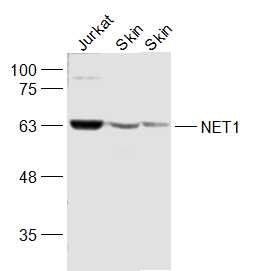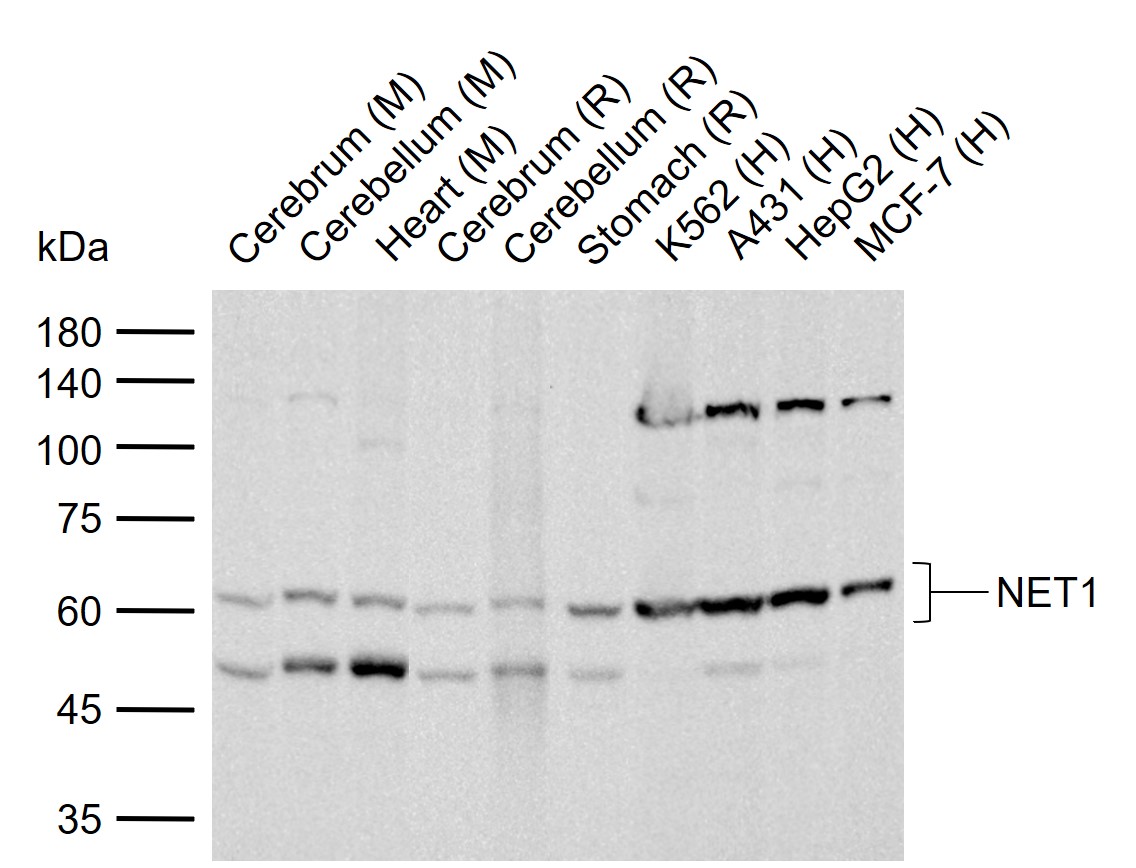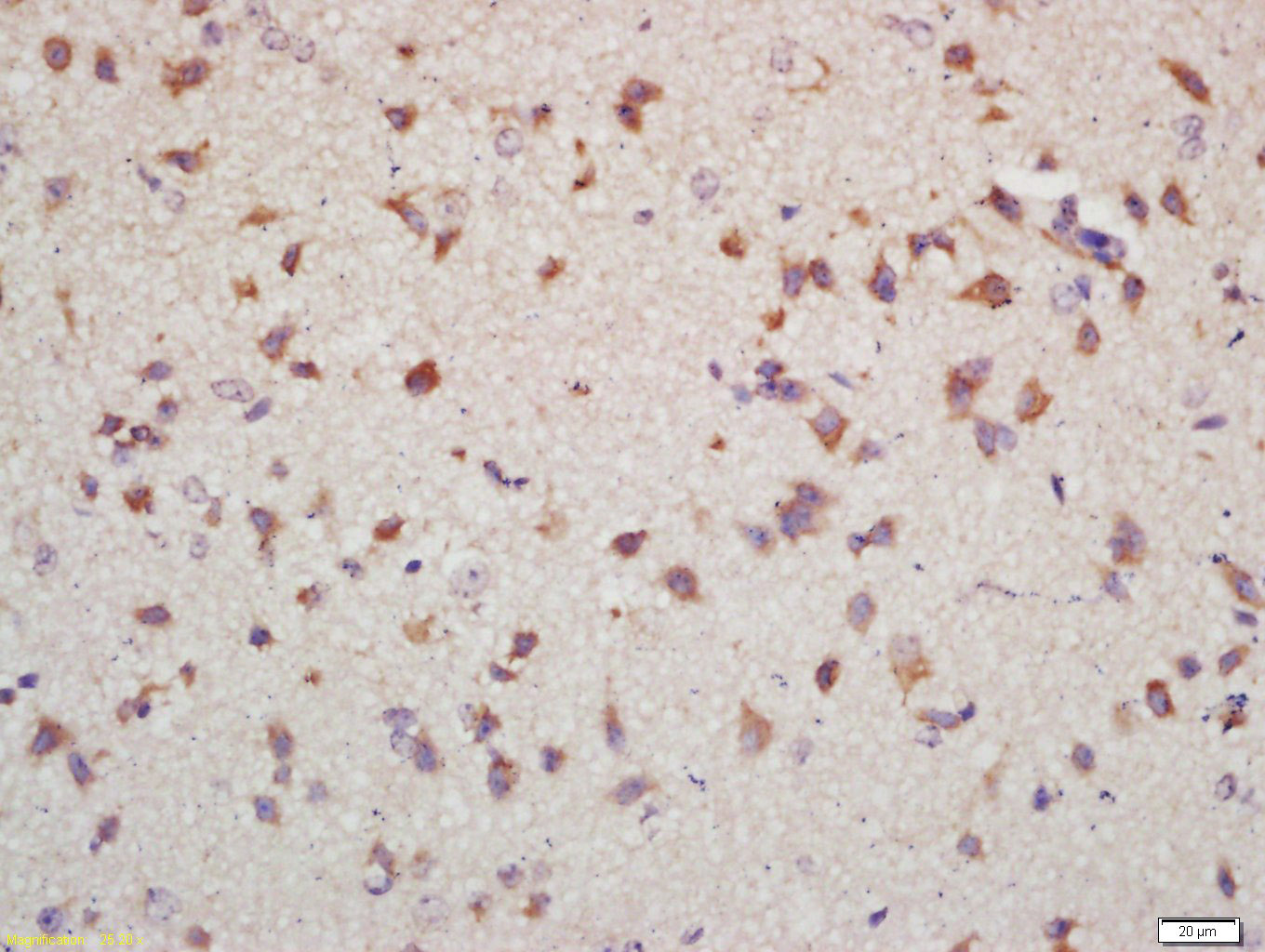
Rabbit Anti-NET1 antibody
NAT1; NET; NET; NET1; Norepinephrine transporter; SLC6A2; SLC6A5; SLC6A5; Sodium dependent noradrenaline transporter; Solute carrier family 6 (neurotransmitter transporter norepinephrine) member 5; Solute carrier family 6 member 2; Solute carrier family 6
View History [Clear]
Details
Product Name NET1 Chinese Name 去甲肾上腺素Transporter/神经递质去甲肾上腺素转运体抗体 Alias NAT1; NET; NET; NET1; Norepinephrine transporter; SLC6A2; SLC6A5; SLC6A5; Sodium dependent noradrenaline transporter; Solute carrier family 6 (neurotransmitter transporter norepinephrine) member 5; Solute carrier family 6 member 2; Solute carrier family 6 member 2. Research Area Cardiovascular Cell biology Neurobiology Signal transduction transcriptional regulatory factor Binding protein Immunogen Species Rabbit Clonality Polyclonal React Species Human, Mouse, Rat, (predicted: Chicken, Dog, Pig, Cow, Horse, Rabbit, Sheep, ) Applications WB=1:500-2000 ELISA=1:5000-10000 IHC-P=1:100-500 IHC-F=1:100-500 ICC=1:100-500 IF=1:100-500 (Paraffin sections need antigen repair)
not yet tested in other applications.
optimal dilutions/concentrations should be determined by the end user.Theoretical molecular weight 65kDa Cellular localization The nucleus cytoplasmic Form Liquid Concentration 1mg/ml immunogen KLH conjugated synthetic peptide derived from human NET1: 151-250/596 Lsotype IgG Purification affinity purified by Protein A Buffer Solution 0.01M TBS(pH7.4) with 1% BSA, 0.03% Proclin300 and 50% Glycerol. Storage Shipped at 4℃. Store at -20 °C for one year. Avoid repeated freeze/thaw cycles. Attention This product as supplied is intended for research use only, not for use in human, therapeutic or diagnostic applications. PubMed PubMed Product Detail Catecholamine, a term used for the hormone adrenaline and its sequentially hydroxylated form noradrenaline, is involved in fight or flight responses. Noradrenaline is released from the post ganglionic sympathetic nerve endings and exerts its effects locally in the immediate vicinity of its release. In the CNS, noradrenaline is involved in a number of physiological responses including mood, sleep regulation, alertness and arousal, both cognitive and non-cognitive expression of behaviors, and control of the endocrine and autonomic nervous systems. Peripherally, noradrenaline is present in sympathetic nerve endings and has full control of the sympathetic nervous system. Noradrenaline released from pre-synaptic nerve terminals is reabsorbed (70-90%) by noradrenaline transporters and its biological effects are terminated. The noradrenaline transport via noradrenaline transporters is an active, Na+/Cl- dependent transport process mediated by noradrenaline transporters. Noradrenaline transporters constitute the primary mechanism for inactivation of synaptically released noradrenaline, are targets for multiple antidepressants and psychostimulants, and are deficient in affective and autonomic disorders. In rat brain, noradrenaline transporter is expressed in noradrenergic neuronal somata, axons and dendrites, and hippocampus and cortex, but is absent from epinephrine- and dopamine-containing neurons. At least 13 genetic variations have been reported in the noradrenaline transporter protein that affect noradrenaline re-uptake and concentrations in cerebrospinal fluid in humans. The association between these genetic variations in noradrenaline transporters and several psychiatric and cardiovascular disorders is just emerging. Recently, a single amino acid mutation (hNET-A457P) showed deficiency in noradrenaline transport in an orthostatic intolerance patient. Noradrenaline transporter protein consists of 617 amino acids and has 12 trans-membrane domains, a characteristic feature of many membrane associated solute transporters.
Function:
Acts as guanine nucleotide exchange factor (GEF) for RhoA GTPase. May be involved in activation of the SAPK/JNK pathway Stimulates genotoxic stress-induced RHOB activity in breast cancer cells leading to their cell death.
Subunit:
Interacts with RHOA in its GTP- and GDP-bound states, and with CDC42 in its GTP-bound state. Interacts with the PDZ 1 domain of BAIAP1.
Subcellular Location:
Cytoplasm. Nucleus.
Tissue Specificity:
Widely expressed.
Similarity:
Contains 1 DH (DBL-homology) domain.
Contains 1 PH domain.
SWISS:
Q7Z628
Gene ID:
10276
Database links:Entrez Gene: 10276 Human
SwissProt: Q7Z628 Human
Unigene: 25155 Human
Product Picture
Jurkat(Human) Cell Lysate at 30 ug
Skin (Mouse) Lysate at 40 ug
Skin (Rat) Lysate at 40 ug
Primary: Anti-NET1 (SL10186R) at 1/1000 dilution
Secondary: IRDye800CW Goat Anti-Rabbit IgG at 1/20000 dilution
Predicted band size: 65 kD
Observed band size: 65 kD
Sample:
Lane 1: Mouse Cerebrum tissue lysates
Lane 2: Mouse Cerebellum tissue lysates
Lane 3: Mouse Heart tissue lysates
Lane 4: Rat Cerebrum tissue lysates
Lane 5: Rat Cerebellum tissue lysates
Lane 6: Rat Stomach tissue lysates
Lane 7: Human K562 cell lysates
Lane 8: Human A431 cell lysates
Lane 9: Human HepG2 cell lysates
Lane 10: Human MCF-7 cell lysates
Primary: Anti-NET1 (SL10186R) at 1/1000 dilution
Secondary: IRDye800CW Goat Anti-Rabbit IgG at 1/20000 dilution
Predicted band size: 65 kDa
Observed band size: 62 kDa
Tissue/cell: mouse brain tissue; 4% Paraformaldehyde-fixed and paraffin-embedded;
Antigen retrieval: citrate buffer ( 0.01M, pH 6.0 ), Boiling bathing for 15min; Block endogenous peroxidase by 3% Hydrogen peroxide for 30min; Blocking buffer (normal goat serum,C-0005) at 37℃ for 20 min;
Incubation: Anti-NET1 Polyclonal Antibody, Unconjugated(SL10186R) 1:200, overnight at 4°C, followed by conjugation to the secondary antibody(SP-0023) and DAB(C-0010) staining
Partial purchase records(bought amounts latest0)
No one bought this product
User Comment(Total0User Comment Num)
- No comment





 +86 571 56623320
+86 571 56623320




